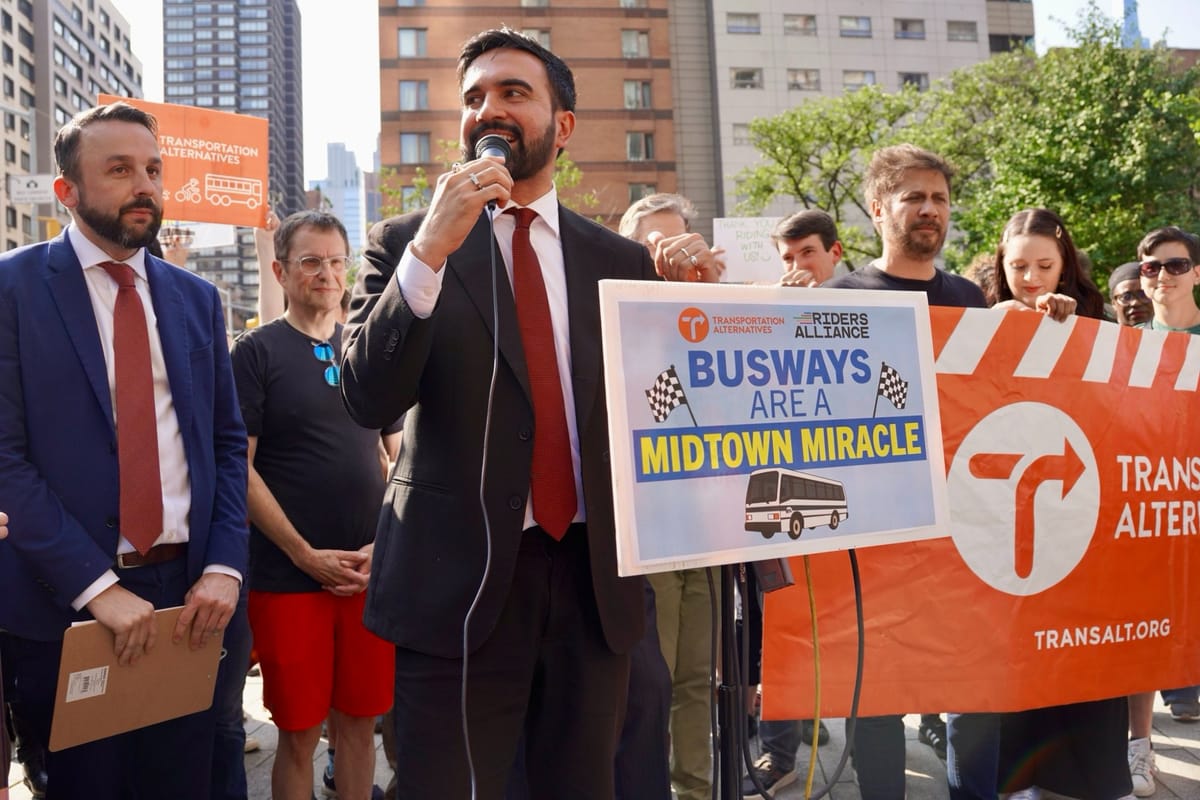A Proposed 5-Step YIMBY Playbook to Fix New York's Housing Crisis
Mamdani made housing affordability and transit the centerpiece of his campaign. Here's everything he could do as mayor to move the needle.

The most talked-about housing policy of Zohran Mamdani's mayoral campaign is his pledge to "freeze the rent" which has sparked extensive discourse. However, it's worth noting that this pledge only applies to a subset of New York's rental housing stock: specifically, apartments built before 1974 subject to New York City's rent stabilization regulation, which make up approximately half of the city's rental building stock. This article is not about that. Rather, this article is about what Zohran can do to not freeze, but actually lower rents on the other half of non-stabilized rental apartments and lower the cost of purchasing a home in New York City. I have written more broadly about the housing crisis and the importance of progressive-pro housing policies and how NYC has been underbuilding housing for half a century, driving up the cost of renting or buying a home.
Zohran has recently been embracing these pro-housing YIMBY (Yes In My Backyard) policies. For example, he signed onto an amicus brief supporting the recent City of Yes upzoning, supported pro-housing statewide legislation, and advocated for repealing the parking mandates that make it more expensive and difficult to build housing. Moreover, Zohran has been embracing pro-housing rhetoric, highlighting the success of Jersey City's pro-housing policies and saying that he has changed his mind on the role of private housing development in making NYC more affordable. While it has been heartening to see Zohran's embrace of pro-housing policies, it has made me think further about what exactly a pro-housing Zohran administration would look like, and how it could benefit New Yorkers. What levers are available to Zohran to achieve the goal of a more affordable, sustainable, and livable New York City?
Step 1: Address Zoning Barriers. New York has been extensively downzoned over the past century, the largest of which was the 1961 downzoning which reduced the city's "zoned capacity" from approximately 55 to 11 million residents. This has been followed by additional piecemeal neighborhood downzonings, particularly under the Bloomberg administration. As a result, New York's housing capacity is artificially limited, to the point where approximately 40% of buildings in Manhattan could not be built today due to new zoning limitations that went into effect after the buildings were first constructed. The aforementioned City of Yes was a good first step to push the needle in favor of more housing, however, many of the provisions in City of Yes were actually quite modest in scale. For example, City of Yes only upzoned to allow 3-5 stories of housing nearby transit stops. While a laudable improvement over the previous status quo, this is still far too modest for a city like New York. As a point of contrast, Vancouver recently passed an upzoning to allow at least 20 stories of housing near transit lines. Transit-oriented development is inherently sustainable, as it enables more transit ridership rather than car trips, significantly reducing carbon emissions. Furthermore, it is inherently more affordable, as residents generally do not need to own a car (the average cost of which has risen to over $1,000/month according to AAA), aligning well with Zohran's affordability focus.
There are two specific areas that Zohran should focus on for transit-oriented upzonings. The first one is Manhattan, which can support very high densities due to its location as the transit and business core of the city. The recent Midtown South Mixed Use Rezoning is a good example of this, creating approximately 10,000 new homes across only ~40 blocks in Manhattan. Applying a similar process to the rest of Manhattan could create hundreds of thousands of new homes, concentrated in wealthy, transit and job-rich areas that are best equipped to support more housing. On top of this, the recent repeal of a little-known state law artificially capping density (specifically floor area ratio, or FAR) of new housing presents a unique opportunity to upzone large portions of Manhattan.
The second place that Zohran should focus on transit-oriented development is the currently under-development Interborough Express (IBX). NYU researchers Eric Goldwyn, Elif Ensari Sucuoglu, and Joao Paulouro recently studied the corridor and found that a comprehensive rezoning plan could create approximately 100,000 new homes over the next decade. Zohran should embrace this proposal and use it to illustrate the inherent synergies between housing and transportation development. Additionally, Hochul views the IBX as a major governing priority, and this would be a great place for the two leaders to work together, avoiding the acrimonious Governor/Mayor dynamics that plagued Cuomo and De Blasio.
Step 2: Fix non-zoning housing barriers. In addition to direct zoning constraints on new housing, there are plenty of non-zoning rules that serve as barriers to building more housing by driving up hard costs and making regulatory compliance difficult. The first example here is elevators, which are subject to bespoke rules far beyond international best practices seen in Western Europe. This drives up construction costs and disincentivizes construction of denser, elevator-accessible apartments. An eye-popping data point is that a new four-stop elevator costs more than four times as much in New York City as it does in Switzerland. This isn't a matter of left vs. right, or socialism vs. liberalism. Rather, it's a simple example of overly-complex, bespoke regulations that fail to achieve their intended goal (safer elevators) and impose significant second-order costs by making construction more expensive, reducing how much housing can be built. On top of that, it means that we get fewer elevators overall, even though elevators make housing more accessible and safe.
Another similar example is tower cranes, which are global best-practice in construction. However, after one accident, NYC imposed rules making it extremely difficult to use tower cranes, resulting in the use of mobile cranes which are far more dangerous and expensive. Again, this is an example of a rule that has backfired by failing to accomplish its direct goal of safer construction and created excessive compliance costs and inefficiencies along the way. The third area that Zohran should focus on is single-stair rules. Single-stair buildings have more efficient, liveable floorplans and lower development costs by reducing the amount of non-livable area that must be built in each building. While NYC is actually a leader here relative to the rest of the US by allowing single-stair buildings up to 6 stories, there is still a way to go to mirror international best practices. Specifically, New York should allow even-taller single stair buildings to align with most of the developed world (for example, Spain allows 9 stories, France allows 16 stories, Italy allows 25 stories, and Switzerland & South Korea allow unlimited height of single-stair buildings). On top of that, single stair buildings in NYC only allow for 2,500 square feet of floor area per floor, further limiting the applicability of this inherently more-affordable building design. Finally, Zohran should accelerate efforts to minimize the use of expensive and dangerous sidewalk sheds. This is yet another example of NYC adopting bespoke regulations that stray from Western European and Asian best practices in a counter-productive attempt to minimize risk.
On top of this, one of the biggest non-zoning barriers to more housing is the inherent risk of NYC's approval process. Today, the New York City council has an informal but de-facto process known as "member deference" that basically means if a councilmember opposes a housing project or rezoning in their district, the rest of the city council "defers" to that councilmember and blocks the project. This creates inherent uncertainty with many housing projects, with a single councilmember able to halt development that would benefit the city as a whole by helping to relieve the housing shortage. Thankfully, in addition to the mayoral election on the ballot in November, there are also multiple ballot measures that would streamline housing approvals in NYC, including creating an "Appeals Board" consisting of the Borough President, Mayor, and City Council Speaker that could overturn housing rejections and would likely have a city-wide pro-housing perspective beyond the parochial interests of a single NIMBY (Not In My Backyard) councilmember. Zohran should forcefully support these pro-housing ballot measures and encourage his supporters to vote yes on them.
Step 3: Effectively harness the power of the public sector. Making rents affordable cannot be accomplished with the private sector alone, especially in today's environment of high interest rates serving as a barrier to development. Accordingly, many local agencies are exploring creative financing options to help get mixed-income housing off the ground. This article from the CPE, a progressive think tank focused on building state capacity, details how Montgomery County, Maryland, was able to encourage mixed-income development through creative public-sector financing mechanisms. While most traditional subsidized "affordable housing" development relies on complex tax credit schemes (LIHTC) or inclusionary zoning mandates (which, if poorly designed, can significantly reduce housing construction), this new option of public financing means that the public sector itself can become the bankers and developers building affordable housing, increasing state capacity and reducing reliance on private investors in a turbulent market.
There are options for Zohran to go even further beyond public sector financing. The city of New York owns approximately 1,800 acres of land classified as having "no current use", an area twice the size of Central Park. The city should seek to develop dense housing on this city-owned land, which is inherently cheaper than acquiring new land for housing. Beyond land with no current use, there are even more parcels of city-owned land that can be redeveloped for dense housing. Libraries offer a clear example: many older NYC libraries need major renovations that can be quite expensive. Rather than spending tens of millions on repairs or rebuilds, the city should reimagine these sites by putting ground-floor libraries at the base of denser apartment buildings, which has already been done successfully in Sunset Park and Inwood. Zohran should look to scale up this program and look beyond libraries, launching a comprehensive search of every single city-owned parcel of land to examine which city-owned office buildings, schools, golf courses, parking lots and more can be rebuilt with dense housing attached. And these are just city-owned parcels of land; Zohran should also be looking at state owned parcels of land to build housing, particularly those owned by the MTA. A good example of this was a recent plan to turn a former bus washing facility into more than a thousand homes in Greenpoint. Unsurprisingly, NIMBYs are mad about this proposal, which is exactly why Zohran needs an all-of-the-above approach to ensure that NIMBYs cannot hijack the broader zoning and approval process to bring these projects to a halt.
Lever 4: Bring in the right people. Zohran needs to surround himself with experienced appointees who are aligned on the importance of building more housing. Historically, mayors have tapped talented civil servants in high roles from previous administrations, despite broader ideological differences. For example, De Blasio hired Bloomberg officials for cabinet-level posts and Eric Adams did the same with De Blasio officials (including Maria Torres-Springer, who we will get to in a moment). While the Adams administration has been a mess at the highest levels due to corruption and haphazard governance, the current Director of City Planning, Dan Garodnick, has been an extremely effective and well-respected leader. Garodnick has successfully taken the reins of many major pro-housing initiatives mentioned earlier, sold them to the public, and pushed them across the finish line. Zohran should absolutely retain Garodnick in this role or even consider promoting him to a Deputy Mayor role. The same goes for Maria Torres-Springer, a De Blasio veteran who Adams appointed as Deputy Mayor of Housing and Economic Development where she was a forceful advocate for, and executor of progressive pro-housing policies. Torres-Springer was subsequently promoted to First Deputy Mayor, where she was universally praised and respected for her effective, competent governing style before she resigned in protest of the Adams’ administration’s corrupt bargain with the Trump Administration. Zohran should seek to bring Torres-Springer back if he can, potentially as First Deputy Mayor.
After Torres-Springer resigned, she was replaced by Randy Mastro, who is most famous for 1) leading the (failed) New Jersey lawsuit to halt congestion pricing and 2) serving as chief of staff for Rudy Giuliani. More recently, as Adams' First Deputy Mayor, Mastro has notoriously halted much-needed bus lanes and housing. While past mayors have let some cabinet officials from prior administrations stay on until they are formally replaced, Zohran should fire Randy Mastro on day one to show that Mastro's brand of conservative NIMBYism is not welcome anymore.
Finally, it's worth noting that the Democratic nominee for Comptroller, Mark Levine, is extremely pro-housing. Zohran should seek to partner with his office on some of the proposals mentioned above.
Step 5: Sell the vision. In order to drive support for policies that will help New York build more housing, Zohran should build a durable pro-housing coalition. He should make the progressive case for YIMBY policies, highlighting how building housing in NYC is an environmental policy as well due to the low-carbon lifestyle enabled by dense housing.
Beyond the environmental case, there is also a labor case: making it easier to build more housing creates union jobs, which is exactly why the Carpenters' Union in California has become one of the driving forces behind pro-housing state legislation. On top of that, building more housing raises the tax base in the city by creating more jobs and more residences paying property taxes. As Mayor, Zohran will be subject to strict fiscal guardrails, and the tax revenue raised by building more housing can be used to fund some of his campaign promises. The tide is already shifting in New York, with socialist and progressive city councillors like Chi Osse and Tiffany Caban leading the charge to build more housing. Zohran should become the new face of progressive, pro-housing policies that will make New York more affordable, more sustainable, and more equitable for all.
It's worth noting that even Zohran going full YIMBY in NYC is just part of the equation, as the city is the hub of a broader metropolitan region that needs an all hands on deck approach to housing. While some nearby cities like Jersey City and New Rochelle are leading the pack and building housing to serve as a release valve for the region's housing crisis, places like Connecticut (where Governor Ned Lamont inexplicably vetoed a housing bill) and Long Island (which might just be the most NIMBY part of the country) need to step up, and Zohran should work with legislative leaders in Albany (and Trenton and Hartford) to support broader pro-housing policies in the region. A good model of state-level legislation that New York should look into is California's SB79, which would legalize mid-rise apartment buildings nearby frequently-served mass transit stops across the state.
New York has always been a city of opportunity and safe haven for marginalized people: immigrants, LGBTQ people, and racial and religious minorities have all found refuge there. However, the state of the housing crisis has created a toxic scarcity mindset where current residents are afraid of new people moving in and raising rents, which is being harnessed by the far-right. We need to reject that view entirely by building enough housing for everyone who wants to call New York City their home.
Featured image is Zohran Mamdani holding a microphone at a rally




